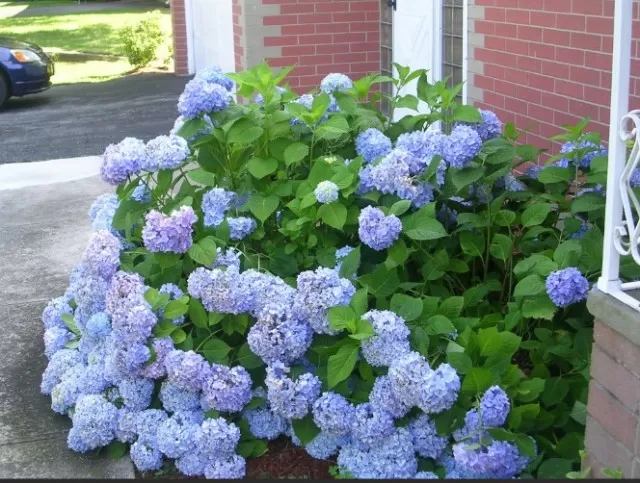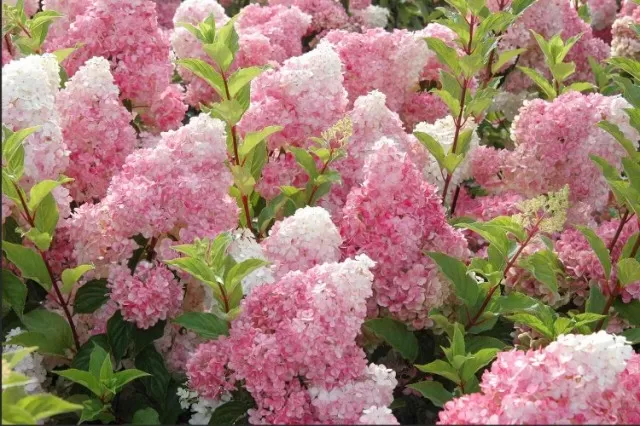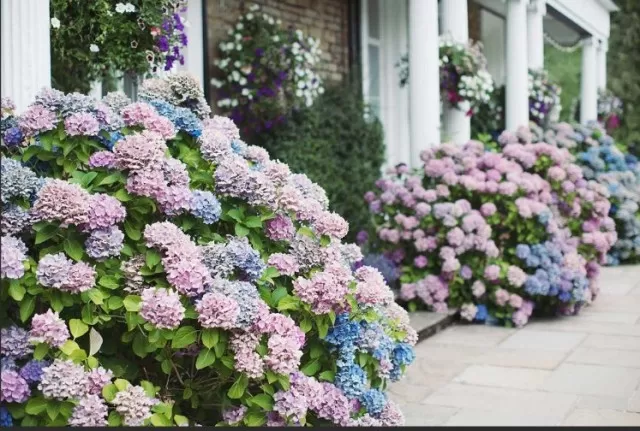Growing Hydrangeas: A Step-by-Step Guide.In the enchanting world of gardens, drama is easily found when you welcome the majestic hydrangeas into your midst. These heritage perennial shrubs are the true stars of the landscape, promising to bestow upon you a spectacle of show-stopping blooms as a delightful reward for a little tender hydrangea care.
With their alluring presence, hydrangeas bring a touch of magic and charm to any lawn. From their elegantly shaped foliage to their stunning flower heads, they effortlessly captivate the hearts of onlookers. The secret to unlocking their full potential lies in offering them just the right amount of attention and care.
As the seasons unfold, hydrangeas reveal an array of hues, ranging from soft pastels to vivid shades, as if telling a tale of their own. From the glorious mophead blooms to the elegant lacecap varieties, each one has a unique story to share.
An Easy Guide to Cultivating Hydrangeas: Everything You Need to Know

Commonly known as Hydrangeas, these beautiful flowering shrubs, scientifically classified as Hydrangea spp.
, can be successfully grown in Hardiness Zones 3 to 9. They are versatile and can adapt to various soil types, with the added bonus that the pH of the soil determines the color of their stunning blooms.
To keep your Hydrangeas thriving, they prefer partial to full sunlight and require watering once to twice a week, adjusting the frequency during dry spells or rainy periods.
The good news is that you don’t need to be a gardening expert to care for Hydrangeas; they are relatively low-maintenance and don’t require additional feeding, as excessive fertilizer can even hinder their blooming potential.
If you’re interested in expanding your Hydrangea collection, they can easily be propagated through stem cuttings or by rooting branches.
While these plants bring joy to any garden, it’s essential to exercise caution as they are toxic to both humans and pets.
So, be mindful of their placement, especially if you have curious animals or young children around.
With this comprehensive guide, you can now confidently grow and nurture your Hydrangeas, adding a touch of elegance and color to your outdoor space.
So, let’s get started on your journey to cultivating these enchanting beauties!.
A Fascinating Look into Hydrangea Characteristics
Hydrangeas, with their ancient origins dating back to the time of dinosaurs, have a long and storied history.
Today, there is an impressive diversity of over 70 species of this beautiful flowering shrub native to the Western United States and Canada. These deciduous woody-stemmed plants are known for their breathtakingly large blooms, which capture the attention of all who behold them. Interestingly, the color of these show-stopping flowers is strongly influenced by the pH of the soil they grow in. When the soil’s pH is below 6. 0, the hydrangea blossoms display mesmerizing shades of blue, while a pH of 7. 0 or higher transforms the blooms into enchanting pinks.
The symbolism associated with the different-colored hydrangea flowers adds a touch of intrigue to these already captivating plants.
According to folklore, blue hydrangeas are often associated with feelings of remorse and gratitude, while their pink counterparts are seen as symbols of romance and affection.
One of the remarkable features of hydrangeas is their rapid growth rate.
These plants can put on an impressive growth spurt, adding up to 2 feet in height per year. Depending on the variety and growing conditions, they can eventually reach towering heights of up to 15 feet and extend their lush foliage to a width of 20 feet.
Due to their vigorous growth, regular pruning is necessary to maintain their shape and encourage optimal blooming. The timing of pruning depends on the type of hydrangea, as some bloom on new wood and should be pruned after their summer blossoms, while others bloom on old wood and are best pruned in late winter.
Beyond their visual appeal, hydrangeas have also been recognized for their medicinal properties.
The roots of these plants have been used traditionally to treat various ailments such as stomach issues and coughs, demonstrating their historical significance in folk medicine. However, it is essential to exercise caution when handling hydrangeas, as the entire plant can be toxic to both humans and pets if ingested.
In conclusion, hydrangeas are a fascinating and multifaceted plant species, blending beauty, symbolism, and practical uses.
Their long history and wide-ranging characteristics make them a captivating addition to any garden, where they continue to enchant and inspire gardeners and nature enthusiasts alike.
Recommended Hydrangea Varieties and Tips for Planting

Hydrangeas offer a wide variety of options with over 600 cultivars, making it a bit challenging to choose the right one.
Here are some excellent selections to consider, along with essential tips for planting these captivating shrubs:.
Macrophylla (H.
macrophylla) – Endless Summer Twist-n-Shout: This beautiful blue lace cap hydrangea boasts reblooming capabilities on both old and new wood throughout the summer until frost. With a medium-size growth of 3 to 5 feet, it serves as a splendid specimen plant in Zones 4 through 9.
Smooth (H.
arborescens) – Annabelle: Known for its classic “snowball” appearance, Annabelle features large 8- to 12-inch white fluffy flower heads that bloom on new wood from early summer to fall. This cold-tolerant hydrangea grows to a height of 3 to 5 feet and prefers partial shade.
Panicle (H.
paniculata) – Bobo: As a dwarf variety, Bobo exhibits large white conical flower heads on new wood from midsummer to fall. With a compact size of 2 to 3 feet in height and width, it works well in both landscapes and container gardens, thriving in full sun to part shade.
Oakleaf (H.
quercifolia) – Gatsby Pink: This variety produces bright-pink conical clusters on old growth during summer, and the color deepens as fall arrives. Gatsby Pink thrives in sun or light shade, reaching a height of 6 to 8 feet.
Climbing (H.
anomala) – Miranda: If you have the space and support, Miranda is a stunning climbing hydrangea that can grow over 30 feet. Though slow-growing, its fragrant white flowers in lace cap form are well worth the wait.
The variegated leaves and exfoliating bark add interest during winter.
When to plant hydrangeas: Fall is the best time to plant hydrangeas, as it allows the plant to establish a healthy root system before flowering.
Alternatively, you can plant them in spring, but ensure you do so early in the season to give them sufficient time to acclimate before the hot weather arrives. Planting in the early morning or late afternoon when temperatures are cooler will minimize stress on the shrub.
Ideal growing locations for hydrangeas: Most hydrangeas thrive in partial sun, making an eastern exposure with some shelter from harsh afternoon glare an ideal spot.
Many gardeners plant them near their homes or in front of fences for added beauty. You can also create a stunning hydrangea garden with various types, bloom colors, or heights in a well-prepared bed.
Be sure to protect hydrangeas from strong winds, but avoid planting them directly under trees where they might compete for water and nutrients.
How to plant hydrangeas: Follow these steps for successful planting:.
Dig a hole about 2 feet wider than the root ball and as deep as the root ball to encourage proper drainage.
Gently loosen the roots after removing the plant from its pot.
Fill the hole halfway with a mixture of soil and up to 15 percent organic compost.
Water the plant.
Once the water is absorbed, finish filling the hole with soil.
Water the hydrangea thoroughly again.
Growing hydrangeas in containers: Certain dwarf varieties are suitable for growing in containers.
Choose cultivars that stay compact, typically reaching heights of 2 to 3 feet. If you plan to keep the hydrangea in a container year-round, select types that can tolerate at least two USDA hardiness zones lower than your location.
Proper watering and ensuring the container has drainage holes are essential for their successful growth.
By considering these recommendations and planting tips, you can enjoy the beauty of hydrangeas and make your garden a delightful haven for these enchanting shrubs.
.
.
.
Hydrangea Watering Tips Made Easy
Proper watering is essential for the health and vitality of your hydrangeas.
Although it may seem daunting, following these simple guidelines will ensure your plants thrive:.
Establishment Period: During the first year or two after planting, focus on encouraging root growth.
Water deeply three times a week throughout the growing season to establish strong roots.
Regular Watering: Throughout the growing season, hydrangeas typically require about 1 inch of water per week.
Regularly check the moisture level of the soil and adjust your watering schedule accordingly.
Drought Conditions: During periods of drought, it’s crucial to provide adequate water to keep your hydrangeas alive.
Pay special attention to bigleaf and smooth hydrangeas, as they may need extra irrigation during dry spells.
Potted Hydrangeas: If you have hydrangeas in containers, they may require more frequent watering.
Potted plants tend to dry out faster, so daily watering might be necessary to keep them healthy.
Wilting Leaves: The leaves of hydrangeas are an excellent indicator of their water needs.
If you notice wilting leaves, it’s a clear sign that your plants are thirsty and require water.
Optimal Watering Time: Water your hydrangeas in the morning.
This allows them to absorb the water before the heat of the day sets in, reducing the risk of evaporation and water stress during peak temperatures.
Watering Technique: When watering, aim to direct the water at the base of the plant, avoiding the flowers and leaves.
This helps prevent issues like foliar diseases and promotes efficient absorption by the roots.
By following these straightforward watering guidelines, you can provide your hydrangeas with the moisture they need to thrive.
Keeping a watchful eye on their water requirements and adjusting your watering routine as needed will ensure these stunning shrubs adorn your garden with their magnificent blooms all season long.
Fertilizing Hydrangeas Made Simple

Fertilizing hydrangeas can significantly impact their growth and blooming.
Here are some straightforward guidelines to ensure your hydrangeas receive the right nutrients without overdoing it:.
Assess Soil Quality: Before applying any fertilizer, evaluate the soil quality.
If your soil is already rich and nutrient-dense, you might not need to fertilize your hydrangeas at all.
Avoid Excessive Nitrogen: Hydrangeas are sensitive to excessive nitrogen, which can lead to lush leaf growth at the expense of flowers.
Avoid using fertilizers high in nitrogen.
Soil Test: If you’re uncertain about your soil’s nutrient levels, conduct a soil test.
A soil test will indicate whether your hydrangeas require additional fertilization and help you choose the right type and amount of fertilizer.
Fertilizing Timing: The best time to fertilize hydrangeas varies depending on the variety:.
Bigleaf Hydrangeas: For bigleaf hydrangeas, light fertilization in March, May, and June is recommended.
Oakleaf and Panicle Varieties: Oakleaf and panicle hydrangeas should be fertilized in April and June.
Smooth Hydrangeas: Smooth hydrangeas require only one application in late winter.
Fertilizer Type: When selecting a fertilizer, opt for an organic, slow-release variety.
Organic fertilizers release nutrients gradually, providing a more sustained feeding to your plants.
By following these simple guidelines, you can provide your hydrangeas with the right nutrients at the appropriate times, ensuring their healthy growth and vibrant blooms.
Remember, it’s always better to err on the side of caution and fertilize sparingly, as too much fertilizer can be detrimental to these stunning shrubs.
*The information is for reference only.